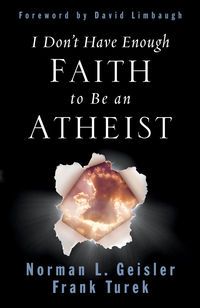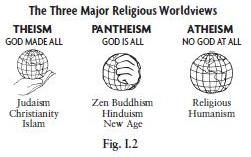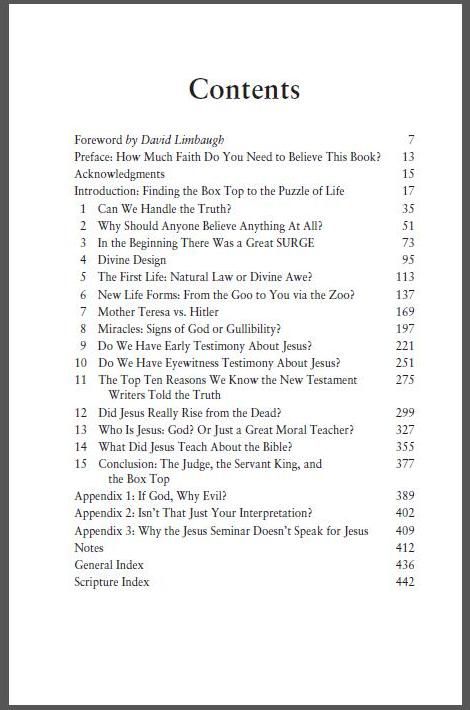 Apologia has generously sent their book, I Don't Have Enough FAITH to Be an ATHEIST to members of the Schoolhouse Review Crew. We also received copies of the companion workbook which serves as Apologia's first apologetics curriculum for highschool students.
Apologia has generously sent their book, I Don't Have Enough FAITH to Be an ATHEIST to members of the Schoolhouse Review Crew. We also received copies of the companion workbook which serves as Apologia's first apologetics curriculum for highschool students.In their book, Norman L. Geisler and Frank Turek will take you on an exciting adventure in which you will discover the "box top to the puzzle of life." Various religions are attempts at providing box tops that show how life's pieces fit together, but which one is right? Can we truly answer the five most consequential questions in life:
1.Where did we come from? (Origin)
2. Who are we? (Identity)
3. Why are we here? (Meaning)
4. How should we live? (Morality)
5. Where are we going? (Destiny)
On your journey, these questions will be addressed and you will be led down a sound path that "proceeds logically from the question of truth all the way to the conclusion that the Bible is the Word of God." Compelling evidence is compiled in logical order using the title of the authors' seminar, "The Twelve Points That Show Christianity is True." Chapters in the book will chronologically cover the following 12 points:
1. Truth about reality is knowable.
2. The opposite of true is false.
3. It is true that the theistic God exists. This is evidenced by the:
a. Beginning of the universe (Cosmological Argument)
b. Design of the universe (Teleological Argument/Anthropic Principle)
c. Design of life (Teleological Argument)
d. Moral Law (Moral Argument)
4. If God exists, then miracles are possible.
5. Miracles can be used to confirm a message from God (i.e., as acts of God to confirm a word from
God).
6. The New Testament is historically reliable. This is evidenced by:
a. Early testimony
b. Eyewitness testimony
c. Uninvented (authentic) testimony
d. Eyewitnesses who were not deceived
7. The New Testament says Jesus claimed to be God.
8. Jesus' claim to be God was miraculously confirmed by:
a. His fulfillment of many prophecies about himself;
b. His sinless life and miraculous deeds;
c. His prediction and accomplishment of his resurrection.
9. Therefore, Jesus is God.
10. Whatever Jesus (who is God) teaches is true.
11. Jesus taught that the Bible is the Word of God.
12. Therefore, it is true that the Bible is the Word of God (and anything opposed to it is false).
The authors show that many scientific laws and principles such as The Law of Noncontradiction, The Law of the Excluded Middle, The Law of Causality (the fundamental principle of science), the First and Second Laws of Thermodynamics, General Relativity, and the Anthropic Principle point to the fact that God exists. As we become more technologically advanced, it's becoming more and more difficult for scientists to explain away the evidence. They resort to coming up with bizarre theories that are purely based on blind faith. No evidence whatsoever. As you will see when you read this book, Christianity is far from being based on blind faith. In fact you will see that it really does take a whole lot more faith to be an atheist!
 The authors explain in the introduction that most of the world's major religions fall into one of three religious worldviews: theism, pantheism, and atheism. They are explained in detail in the book, but the image on the right provides a quick and easy way to remember them. Agnosticism is also discussed in the book.
The authors explain in the introduction that most of the world's major religions fall into one of three religious worldviews: theism, pantheism, and atheism. They are explained in detail in the book, but the image on the right provides a quick and easy way to remember them. Agnosticism is also discussed in the book.I feel so blessed to be a part of this review as this curriculum is proving to be an excellent resource that logically and scientifically builds a solid case for Intelligent Design while revealing the fatal flaws of atheistic and pantheistic worldviews.
To get an idea of the material covered in the book, take a look at the Table of Contents below.
When I first started reading the book, my plan was to complete the assignments in the workbook, too. However, after reading the first chapter and doing the workbook, I quickly realized that I wasn't going to get very far if I kept at that pace. For review purposes I wanted to get through more than 2 chapters! From then on I just took notes and underlined passages as I read. I made it through chapter 5 - it's meaty stuff!
You'll learn that truth is discovered - not invented - and that it's absolute, exclusive, and knowable! With the Roadrunner Tactic, you'll become an expert at identifying and refuting self-defeating statements. You'll see how truth is known by using the self-evident laws of logic and by observing the world around you through induction. When the theory of General Relativity was confirmed to be true, you'll witness the irritation of a very well known scientist who had to admit that the universe had a beginning. Moving on, you'll be exposed to persuasive evidence (anthropic constants) that point to a Divine Designer - God. And finally, you'll see up close just how unbelievable the idea of spontaneous generation is! And that's just from chapters 1-5. I can't wait to read the rest of the book - won't you join me?
 The Workbook was created to help students recall crucial points about Christianity and the other worldviews discussed in the book, I Don't Have enough FAITH to Be an ATHEIST. Understanding and memorizing the arguments presented in the book will prepare Christians to "always be ready to give an answer" for the hope that we have in Christ. (1 Peter 3:15)
The Workbook was created to help students recall crucial points about Christianity and the other worldviews discussed in the book, I Don't Have enough FAITH to Be an ATHEIST. Understanding and memorizing the arguments presented in the book will prepare Christians to "always be ready to give an answer" for the hope that we have in Christ. (1 Peter 3:15)It is suggested that students should spend about 2-3 weeks on each chapter. This should allow plenty of time to complete all of the study questions and assignments. According to this schedule, the course can be completed in less than 9 months.
Each chapter in the workbook is divided into 4 main sections: Hook, Book, Look, and Took.
Hook: This section provides friendly reminders of what was talked about in the chapter and often includes a few questions to get your brain juices flowing.
Book: Here, you'll dig a little deeper, and your knowledge and comprehension will be tested with questions from the textbook.
Look: The authors don't want you to just take their word for it. Research assignments and activities will encourage you to check out information presented in the book for yourself.
Took: This section summarizes the material and helps you apply the concepts in the book to your life.
Hook, Book, Look, and Took are basically the meat of the workbook, but there are also other components. At the very beginning of each chapter, you will be informed of which points in the road map of the "Twelve Points That Prove Christianity Is True" will be covered. Key Topics discussed are provided and so are Key Terms which you will be asked to define.
My favorite part of the workbook is the inclusion of short biographies at various points in the lessons. I love learning about the lives of historical figures! Some of the key people featured are C.S. Lewis, Friedrich Nietzsche, Immanuel Kant, Edwin Hubble, Stephen Jay Gould, Clement of Rome, Alexander the Great, Tiberius Caesar, Adolf Hitler, Richard Dawkins, and Mother Teresa. I must confess, I've spent some of my time skipping to these profiles and reading them before I was technically supposed to. I will reread them, though, when I come to them again. :)
Also, sometimes certain topics mentioned in the book are expounded upon in the workbook to help you understand the concepts better. A few of these include Einstein's Theory Of General Relativity, The Second Law Of Thermodynamics, The Anthropic Principle, The Dead Sea Scrolls, and Nontheistic Religions. Not only are these extras helpful, they are interesting to read.
As I close, I think it is wise to note that the authors make it clear that they do not believe that evidence alone can convert a nonbeliever to a saving faith. The information in the book is still important, though. As C.S. Lewis put it, "good philosophy must exist, if for no other reason, because bad philosophy needs to be answered."
The book is listed on the Apologia website for $16. (Can be found on Amazon in paperback and also for Kindle.)
The workbook is also listed on the website for $33.
See what other Crew Members are saying here.




No comments:
Post a Comment